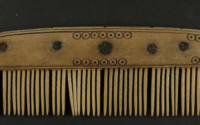Event Information
Artefactual Geographies of the Viking World; reconstructing trade, communication and movement through the analysis of bone artefacts.
Dr Steve Ashby, Senior Lecturer, Department of Archaeology, University of York
We often view travel and trade in the Viking world through the study of high-value goods like silver, weaponry, or jewellery, but does this tell the whole story? Recent developments in biomolecular science have opened up the opportunity to explore connectivity using more everyday items, and here we focus on one such item: the Viking hair comb. These objects were painstakingly produced by specialists using a particular material: deer antler. By studying the combs themselves, together with the materials from which they are made, we can throw new light on old questions about the timing and nature of contact between different parts of the Viking world. This lecture will take us from the mountains of Norway to the bustling trading towns of Denmark and Germany, and across the Atlantic to Greenland, with many stops along the way.
The winners of the Charles Wellbeloved and Herman Ramm awards to University of York Archaeology Department students will be announced at the beginning of the lecture.
7pm in the Tempest Anderson Lecture Theatre in the Yorkshire Museum
All welcome to this free event; although donations are welcome.
Image: Viking comb from Hedeby, northern Germany. Image by Mariana Muñoz-Rodriguez
Member’s report:
Archaeology is mostly the study of small, everyday objects and their place in the lives of ordinary people. In this fascinating talk, Steve Ashby discussed the ways in which the stories of familiar personal objects can connect us with those past lives whilst also contributing to the discussion of big questions.
Animal bone was a widely-used material in the past. It was cheap and available, and could be worked with a similar range of tools to those of the carpenter. Steve has a long-standing interest in combs, which are common objects in Viking-era finds asemblages. Although broadly similar in form, they vary in shape and decoration, and so could be used to make a statement about individual status, tastes or family connections. Viking combs were nearly always made of antler, produced by dismantling an antler to give flat tooth-plates and slightly curved back-plates by which the teeth are clamped in place. The back-plates were riveted together, with variations in rivet material and position being characteristic of combs from different regions.
What about the choice of antler? Here, Steve’s talk broadened out to exploring trade connections across the North Sea. Did the Vikings appear in Britain suddenly or had there been a period of earlier contact? A few combs in ‘Pictish’ contexts, identified as made of reindeer antler, have been used to argue for pre-Viking contact with northern Scandinavia. Using a new technique that analyses the peptide sequences in bone collagen, Steve showed that the ‘reindeer’ combs were actually made from red deer antler, apart from a couple of early Viking date. Was reindeer antler transported and traded within Scandinavia?
The talk moved to the Danish town of Ribe, where very fine stratigraphy and dating provides an excellent opportunity to explore the development of combs. In the early 8th century, there was some contact with northern Scandinavia shown by just a couple of reindeer combs. By the late 8th to early 9th centuries, there are more reindeer antler combs and reindeer working waste, showing that combs were being made in the town and it was the antlers that were being traded. In contrast, combs from the late 8th to 10th century Danish town of Hedeby were mostly of reindeer antler but the town has yielded no unworked reindeer antler, so Hedeby was acquiring the finished products, not the raw material. Among the Hedeby combs there is a style of comb known as ‘Frisian’ after a supposed association with that part of northwestern Europe. The Hedeby examples are made of reindeer antler, showing them to have come from Scandinavia rather than Frisia. What about ‘Frisian’ combs from Frisia? They turned out to be mostly made of red deer antler, apart from the Ambrosiani A2 style that turned out to be reindeer, even the examples from Frisia.
Beginning with a fairly mundane personal possession, we can see how raw materials and finished products moved around early medieval Europe, and perhaps how designs did so too. Comb styles seem to reflect fashions and tastes that were current over quite large areas, a reminder that early medieval peoples were by no means isolated or insular. Later in the medieval period, comb manufacture became almost industrial, expanding the range of raw material to include post-cranial bone. The research goes on, and an excellent talk that began with the small, everyday details of how to make an antler comb ended with intriguing questions about the origins and nature of what we know as the Viking Age.
Terry O’Connor
Feb 2024

